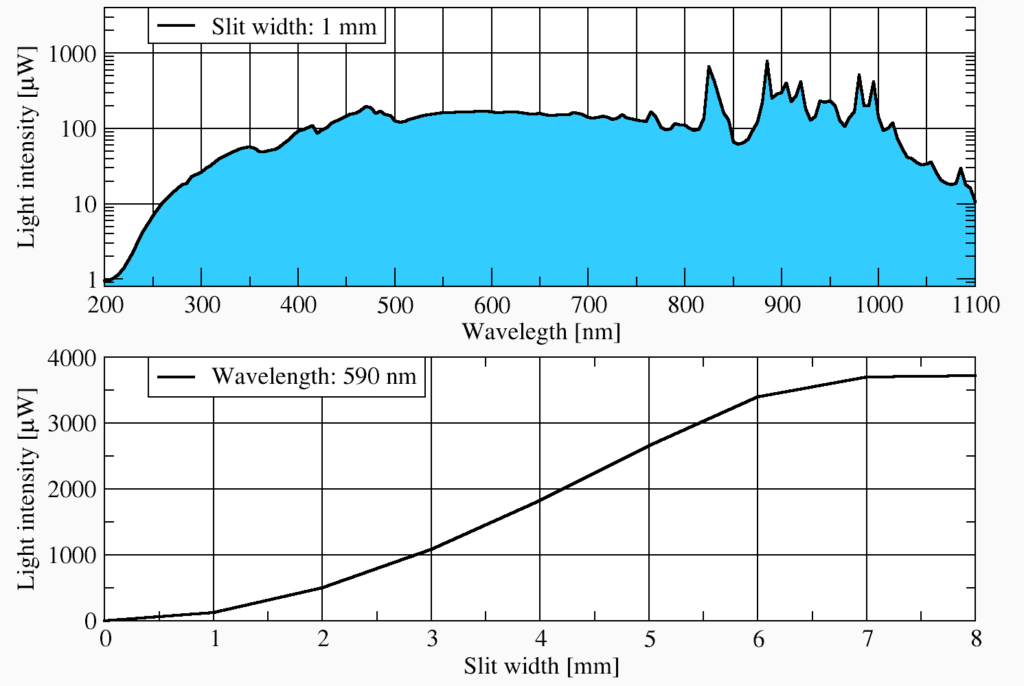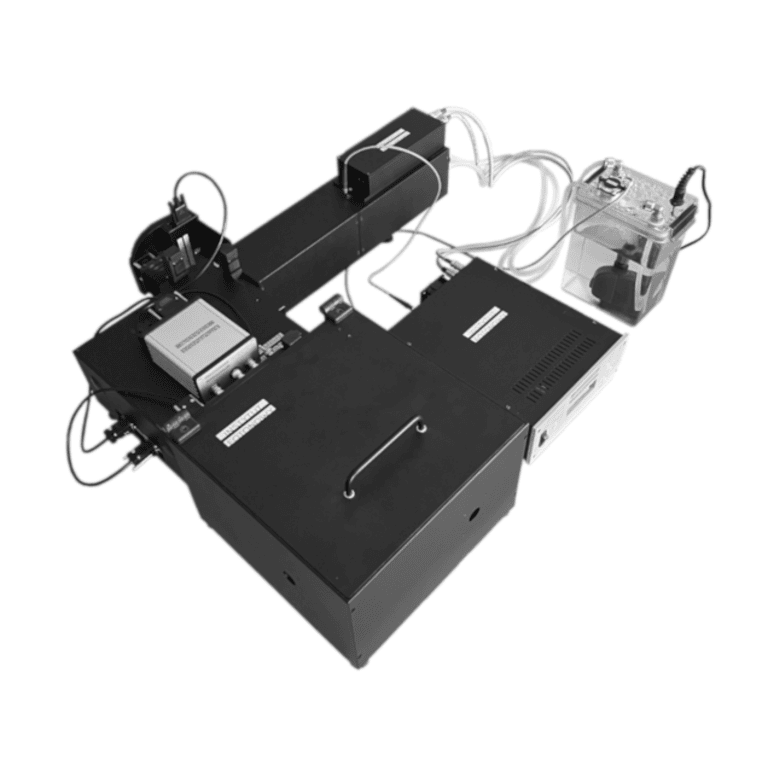Extended Photoelectrochemical (PEC) Measurement Station for static and kinetic quantities exploration. Fully automated system for comprehensive characterization of photoelectric properties using both static and dynamic techniques.
Extended Photoelectrochemical (PEC) Measurement Station
Description

 Extended Photoelectrochemical (PEC) Measurement Station
Extended Photoelectrochemical (PEC) Measurement Station
The Extended Photoelectrochemical (PEC) Measurement Station is equipped with the Monochromator and the Xenon Illuminator to provide wide range of incident wavelengths: UV, VIS and NIR. Xenon Illuminator with the Air Mass 1.5G Filter may also serve as the Solar Simulator.
⬛ Quantities measured by the instrument:
- Electric current through the sample at a given bias potential (chronoamperometry, CA),
- Open Circuit Potential (OCP) as a function of light wavelength or in dark,
- Photocurrent of the sample illuminated with solar (AM 1.5G) or monochromatic light,
- I-V characteristics,
- Incident light intensity reaching the sample,
- Action maps (photocurrent as a function of potential and wavelength),
- IPCE maps as a function of potential and wavelength,
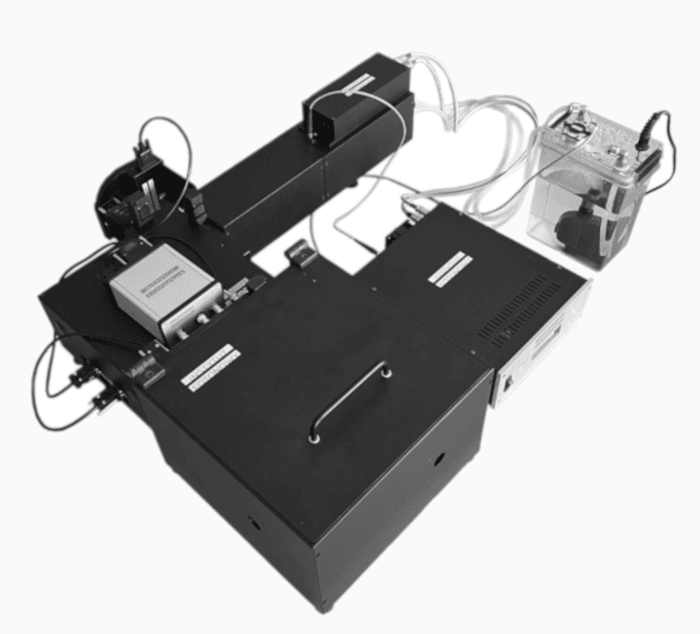
PEC station modules
⬛ Electrochemical Shielding Box,
⬛ Monochromator for UV, VIS and IR light,
⬛ Potentiostat for full characterization of electric properties,
⬛ Xenon Illuminator with the controller and water cooling system,
⬛ Electrochemical Cuvette with Pt Counter Electrode (CE) and Ag/AgCl
⬛Reference Electrode (RE),
⬛ LED Changer with optional IMPS/IMVS extension,
⬛ Time-Resolved Impedance Spectroscopy Analyzer,
⬛ FotoGUI software.
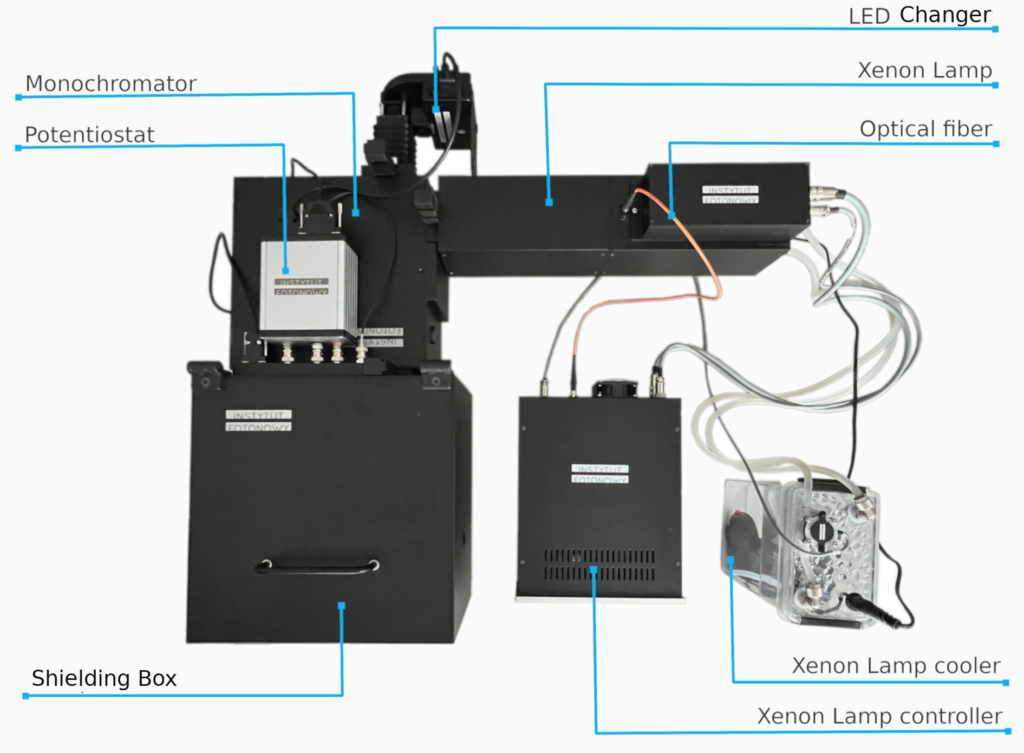
Inside the Shielding Box
⬛ Sample Chamber with the Electrochemical Cuvette

PEC Measurement Station may be extended with:
⬛ Light Power and Intensity Detector,
⬛ Integrating Sphere,
⬛ Intensity-Modulated Photocurrent & Photovoltage Spectroscopy System,
⬛ Time-Resolved Impedance Spectroscopy Analyzer,
With the Extended PEC Station various measurement techniques may be applied to the sample without moving it between different measuring setups.
⬛ Light Power and Intensity Detector extension
Light Power and Intensity Detector enables to investigate light transmission through the sample if assembled behind the sample. Device may be also used to on-demand system recalibrations.
🡆 Quantities measured by the system with the Light Power and Intensity Detector extension:
- Light transmittance of the sample,

⬛ Integrating Sphere extension
The modular design of the system enables to easily attach the Integrating Sphere inside the Electrochemical Shielding Box and detach it to return to the regular functionality.
🡆 Quantities measured by the system with the Integrating Sphere extension:
APCE maps as a function of potential and wavelength,
Sample reflectance.
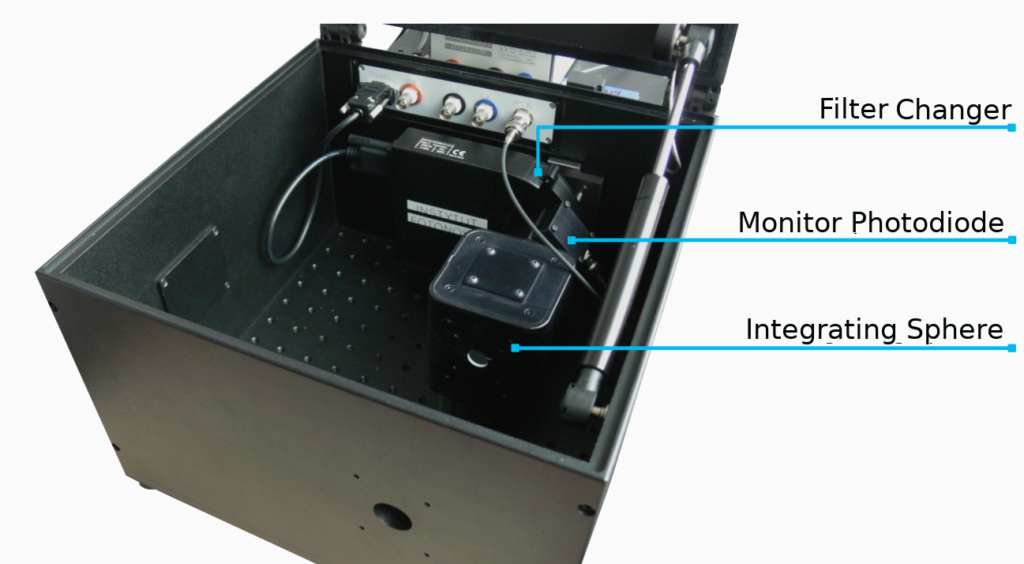
⬛ Intensity-Modulated Photocurrent & Photovoltage Spectroscopy extension
The second Monochromator input may be optionally occupied with the LED Changer with 10 LED sources. The LED Changer may be extended with the light intensity modulation module for time scales investigations. The light from the selected LED may be directed to the Electrochemical Shielding Box via the mirror or the grating on the Monochromator turret. Combining the LED Changer with the grating provides better spectral resolution and wide light intensity modulation range.
The light source selection and its operation is controlled via software.
🡆 Quantities measured by the system with the IMPS/IMVS extension:
- Minority carriers lifetime (recombination time),
- Carrier transport time through the sample,
- Rate of the charge transfer through the interfaces,
- Diffusion constant,
- Diffusion length for a given sample thickness,
- Sample thickness for a given diffusion length,
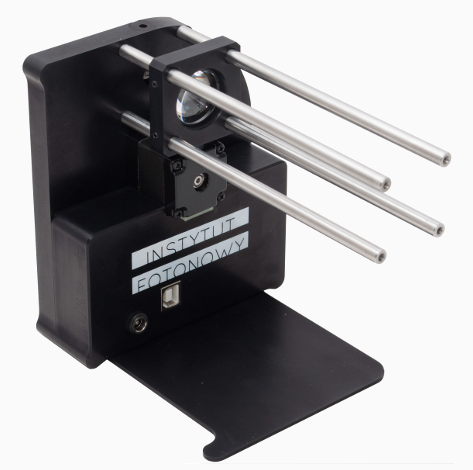
⬛ Time-Resolved Impedance Spectroscopy extension
The extension enables to investigate the dynamics of different types of samples, such as electrochemical sensors, materials that changes its properties when exposed to a given agent (light, temperature, catalyst, etc.) and others.
The device measures current flowing through the sample and voltage on the sample in response to a voltage signal generated as a superposition of frequencies.
🡆 Quantities measured by the system with the Time-Resolved Impedance Spectroscopy extension:
- Self-consistent Electrochemical Impedance Spectroscopy (EIS) spectra,
- Non-linear effects: higher harmonics generation, intermodulation (two frequencies in the input result in a third frequency in the output), current rectification (resistance of a sample depends on the current direction),
- Other kinetic quantities.
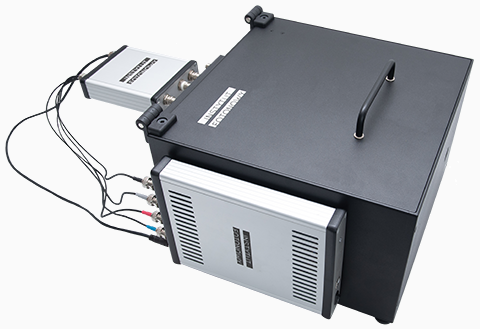
Specifications
⬛ Xenon Lamp
- 150 W xenon burner,
- Water cooling system,
- Low EM emission igniter,
- Stabilization modes:
– electric current stabilization (distortions < 1%),
– electric power stabilization,
– light intensity stabilization (unique solution to provide constant sample illumination during the experiment),
⬛ Filter Changer
- Up to six filters on the carousel,
- Two edge (long pass) filters provided by default: 400 nm and 510 nm,
- Air Mass 1.5G filter,
⬛ Potentiostat
- Bias potential range: -5 V ÷ 5 V,
- Current ranges: 10 nA, 100 nA, 1 µA, 10 µA, 100 µA, 1 mA, 10 mA,
- Current resolution: from 1 pA to 100 nA (range dependent),
⬛ Controller
- Maximum sampling rate: 1 kSample/s,
- Connection with PC: via USB 2.0,
- Two photodiode inputs that may be simultaneously handled,
- RS485 socket to control devices,
⬛ Monochromator UV/VIS/NIR
- Two input slits for two separated light sources,
- Automated light source selection,
- Up to three gratings on the turret,
- A mirror and two gratings installed by default: optimized for 300 nm and 500 nm, both with 1200 grooves/mm,
- Spectral range: 200 ÷ 1200 nm (gratings dependent),
- Automated switching of the turret position, operated via software,
- Motorized slits, controlled via software,
- Entrance and output slit opening range: 0 ÷ 5 mm,
- Motorized internal shutter that provides full cut off of the light beam, controlled via software,
- Maximum spectral resolution: 0.1 nm (depends on the input and output slits width),
⬛ LED Changer
- 10 LED slots,
- Default LED set: 365 nm, 385 nm, 405 nm, 450 nm, 520 nm, 590 nm, 630 nm, 740 nm, 840 nm, white (3000 K),
- Custom LED selection available,
- Typical electric power of LEDs: 3W,
- Light intensity modulation: square, sinusoidal, triangle, sawtooth waveforms with adjustable amplitude and bias light intensity,
- Light modulation frequency range: 1 µHz ÷ 10 kHz.
⬛ Time-Resolved Impedance Spectroscopy Analyzer
- Frequency range: 1 mHz ÷ 1 MHz,
- Sampling rates: 1.22 kHz ÷ 10 MHz,
- Current ranges: 1 mA, 100 μA, 10 μA, 1 μA, 100 nA, 10 nA,
- Current resolution: < 1 pA,
- Voltage range: -1 V ÷ 1 V,
- Voltage resolution: < 100 μV,
Typical light intensity output of the PEC Measurement Station delivered by the Xenon Lamp
🡆 The light intensity produced on the sample depends on the wavelength and width of the input and output slits. In the picture, a typical light intensity from the Xenon Lamp and two 1200 gr/mm gratings: optimized for 300 nm and for 500 nm installed in the Monochromator.
